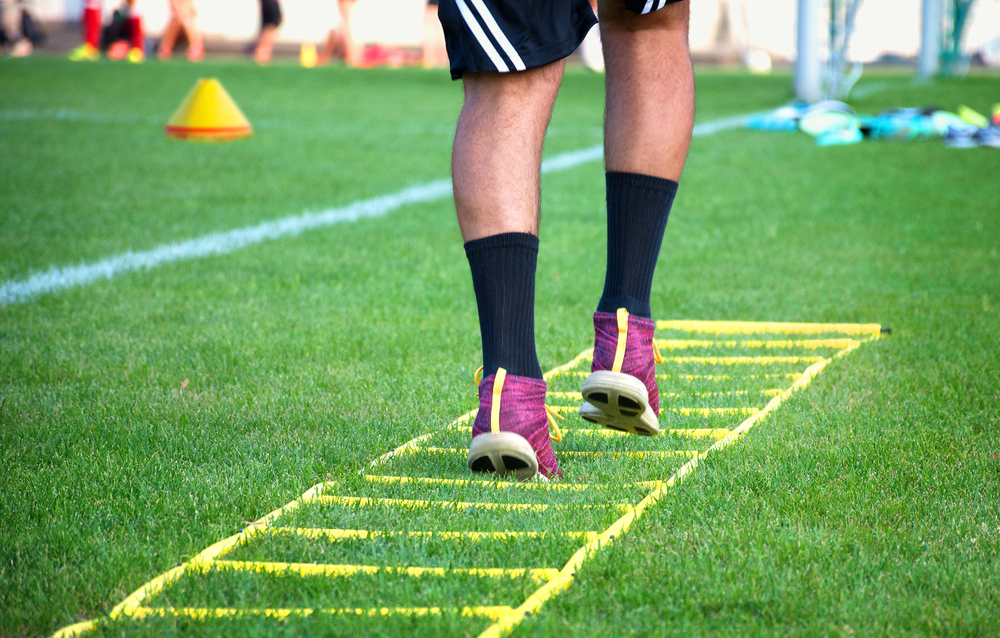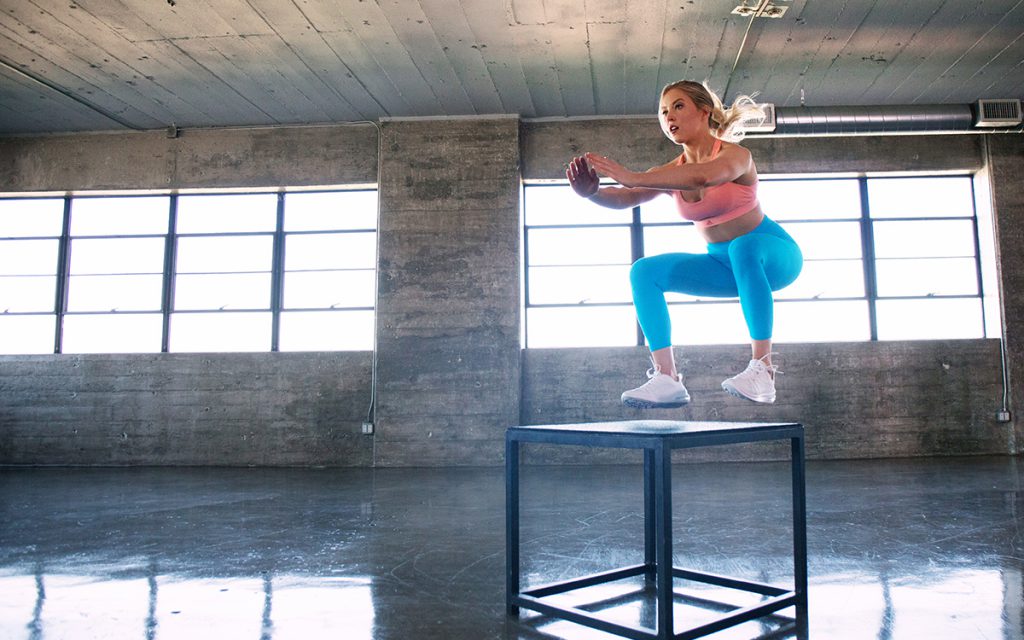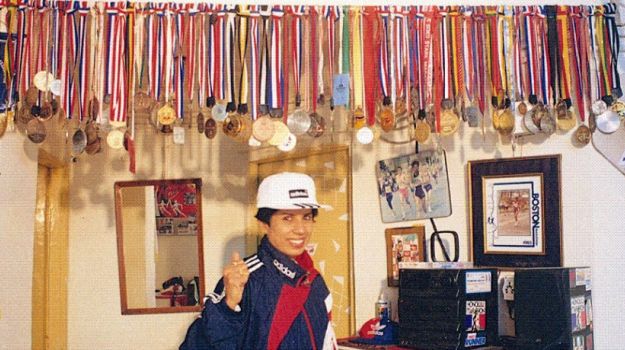For many lifters, building muscle is always the priority. Go too far down that road without speed and agility training, though, and you might find that you have tons of mass with no quickness or endurance.
While it is true that too much speed and agility training can burn enough calories to affect muscle gains, the right amount will help you cut and make your existing muscles more visible. For people who aren’t looking for a bodybuilder physique but just trying to reach a certain level of fitness, speed and agility training is essential.
This guide includes the best of the best exercises for building speed and agility. Read on to find out all about these exercises and the most effective way to include them into your workout routine.
(Note: Want our elite trainers to help you refine your speed and agility? Start your Fitplan free trial today!)
What Is Speed & Agility Training?
Speed and agility are similar but not exactly the same. Quickness is adjacent to both but again merits its own category. If you’re confused about the difference between the three, use the definitions below.
Speed
This category describes how fast you can run in a straight line. Although we do move our arms and legs as we run, the speed at which you can move each one is not the main determiner of your top speed. Research shows that ground force is more important.
Agility
The ability to pivot and make a sudden change of direction is called agility. Sprinting may be important for soccer players and football players, but sudden changes in direction are needed for almost all team sports athletes from basketball players to volleyball players.
Quickness
Rather than being in motion and pivoting, quickness describes how fast you can get into position. Imagine the fight or flight response – quickness is your reaction time.
These factors are all critical for athletes. They’re also important skills to build for daily activities. The last thing you want is muscle that’s all for show.
Speed and agility training emphasizes varying speed and body position. Doing so improves the various stabilizer muscles needed to maintain balance so that when you pivot or get into a stance your body can accommodate the movement.
Helpful Hint: Improve your speed and agility with our Total Body Jump Rope Shred Fitplan!

The Mechanics of Running
To some extent, having bigger muscles and more lower-body power will increase your speed. Remember, speed measures how fast you can run in a straight line.
Researchers have discovered that running happens in a couple of distinct stages. In the beginning, when the person is running slower, longer strides account for most of the increase in speed. Later, when they’re running quickly, increased stride frequency allows people to move faster.
That divide between jogging and sprinting is pretty much uniform for all people. Faster runners have briefer contact with the ground and exert more force while slower runners apply less force and have contact with the ground for longer.
Runners have been debating the best foot placement for faster running for decades. Some say the heel should hit the ground first, giving your foot more contact with the ground and effectively giving you longer legs. For others, the ball of your feet should make first contact with the ground so you can move forward more quickly.
Your upper body does have to move forward before you can take the next step while you’re running or jogging. But landing on your heels constantly strains your lower legs and could cause painful shin splints. The best method to maximize the power on each footfall and give your upper body time to move forward without risking injury is to land on the balls of your feet and roll to the toe before lifting off again.
Muscles Worked in Speed & Agility Training
The human body employs tuns of muscles in order to run. Your core muscles, hip flexors, glutes, quads, calves, and hamstrings all have some part to play. The tendons and ligaments that hold these muscles to the body’s bone structure are also strengthened with more frequent use.
Your knees, quads, and hip extensors work harder when you run downhill while your calves and ankles bear more of the pressure while running uphill. Running on an incline also requires a shorter footfall, meaning you might hit just before the center of your foot or even on your toes depending on how steep the elevation is.
When you change direction, your glutes are doing most of the work. Your hip flexors are most important for picking up speed and your quadriceps are the most important for deceleration. Luckily, there are plenty of great agility drills and speed training exercises that promote the activation of all these critical muscles.
Helpful Hint: Get used to interval training with our Circuit Sweat at Home Fitplan!
7 Best Speed & Agility Training Drills
Add some of these sports performance and strength training exercises to your next training session to kick your overall endurance and performance up to the next level.
1. Speed Ladder Agility Drills
You can use a speed ladder in a few different ways to round out your agility training and get better footwork. Both of the main speed ladder agility drills we’ll mention require you to run through the squares of the ladder. Practice each slowly at first until you can build up speed without misstepping.

Forward High-Knee
Lay the speed ladder out flat on the ground so that the square between each rung is roughly the same size. Starting from one end, lift your right leg until your thigh is parallel with the ground, and then place the right foot in the next square. Repeat the same process with the left leg.
If you prefer, you can put your left leg in the same square as the right foot and only progress to the next square with your right foot each time. You will get a different stretch taking wider steps, so feel free to change it up whenever you want.
Lateral Jog
Since you’ll be running sideways, this lateral exercise will likely go more slowly than the forward version. Start at one end of the ladder and go sideways, placing first your right foot and then your left into the first square and progressing until the end.
Some agility coaches like to have their trainees mix in high-knees on this exercise. It’s certainly possible to do, but at the beginning, all you need to make sure you do is get through the speed ladder without tripping yourself up or stepping on one of the ladder’s rungs.
2. Plyometric Agility Hurdles
This exercise relies on the explosive power of plyometrics. All you need are a few hurdles. If you don’t have those available, anything you can jump high enough to clear and don’t feel bad about possibly damaging can work as an ad hoc hurdle.
Set the hurdles far enough apart that you can land in the middle but close enough together that you can jump over one right after you clear another. About two feet of distance should be enough.
Start about two feet away from your first hurdle. Keep your feet firmly planted on the ground a bit further than hip-width apart. Jump up by pushing through the balls of your feet, making sure you also channel part of your energy into propelling yourself forward so you can clear the hurdle.
Prevent injury by landing on the balls of your feet. Without taking any additional steps, jump up again to clear the next hurdle. Continue for 12 total jumps. If you don’t have that many hurdles, simply turn around and jump in the other direction.
The explosiveness of this exercise is what makes it so effective at building the lower-body muscles and leg strength you need for jumping. Make it extra challenging by jumping with one leg only. Just make sure you do the same for the other leg to get an even workout.
3. Lateral Plyometric Jumps
One of the most popular speed drills for athletes in high school and beyond, this simple exercise only requires a straight line. You can use tape, cones, or just find a naturally occurring straight line. Try to avoid concrete for maximum injury prevention.
Stand on one side of the straight line with your feet no more than hip-width apart. Bend down without hinging at the hips until you’re nearly in a squat position. Push through your feet so that you jump up and sideways to land softly on the other side of the straight line.
Repeat the movement to cross the line once again. If you want, you can also propel yourself forward for an additional workout. As you build leg strength, try increasing the height of the straight line.
Consider jumping forward and diagonally as well. The new direction will give you additional explosiveness and agility.
Helpful Hint: Learn even more versatile exercises as part of our Bodyweight Essentials Fitplan!
4. Box Drills
A box is a versatile workout tool for building speed and agility. There are several ways you can use one in your routine.
Step-Ups
This is a straightforward exercise that will slowly build strength in your legs and knees. All you need to do is stand in front of the box and then take a step up onto it with one leg. Push through that same leg to raise your body up onto the platform.
The best thing about this exercise is that you can change it up in so many ways. For example, you could make it a single-leg exercise or you could lift your second leg up behind you once you’re up on the box. Plyometric explosiveness can be added by inserting a jump at the end of the move. Any of these variations will improve your balance over time.

Box Jumps
If you want to focus on plyometric explosiveness, make box jumps part of your routine. All you have to do is stand in front of the box and then jump up on top of it. Land with both feet and then jump back to where you started.
To make this move challenging in different ways, consider holding dumbbells. You can also stand to one side of the box and do a lateral jump instead of a forward one.
Burpee Jumps
This exercise has a few stages but it also offers a full-body workout rather than concentrating on the lower body alone.
Start in front of the box. Jump straight up and land back on your feet softly. Get down immediately and do one push-up.
Once you’re back in the standing position, complete a forward box jump. That’s one rep. While this exercise takes a bit longer than some others, the strength gains are worth it.
5. Spot Drills
You can also get a good speed and agility workout with five spots. It’s best to use tape or something similar that you can land on without slipping. Place four of the spots in a square shape and put the remaining one in the center.
These markers should be close enough that you can stand on two of the outside ones with both feet. The square should be four or five feet wide. Stand on two of the outside spots facing the center of the square.
Jump to the center spot and land on it with both feet together. Then proceed to jump again to the other outside dots. From here, you can either jump back to the starting position or you can jump straight up once to turn yourself around.
If you want to improve your footwork, practice moving one foot to the center dot and the other to the opposite side of the square. Bring your first foot to the other side of the square and then repeat the same thing backward, leading with the opposite foot.
6. Tuck Jumps
This bodyweight move is ideal for people who are working out from home or at their desk. You don’t need any additional equipment at all and you’ll get a similar workout to the other plyometric jumping exercises in this guide.
Stand with your feet shoulder-width apart, knees slightly bent, and arms at your side. Jump straight up and bring your knees to your chest as you do so. Wrap your arms around your knees at the top of the jump and then let them go to land softly back in the starting position.
Immediately begin your second jump once you land and continue with minimal intervals. That will give you more cardio and a much more challenging workout.
7. Skaters
In this move, you’ll be mimicking the movement of an ice skater. You can break out the agility ladder again if you want to have a guide and make sure you’re consistently jumping the same distance.
Stand with your back to the ladder if you’re using one. Jump to one side and land on your leading foot. Rather than bringing your other foot to meet it, bring it behind you about the length of one stride. Tap the toe of the rear foot on the ground and then bring that foot out.
Jump with the back foot leading so that you’re a few feet away. Repeat the same toe-tap move but mirrored. Continue jumping back and forth like this until you’ve completed 10 toe touches with each foot.
Skaters will give you much more explosiveness and sideways agility. It can be challenging to build lateral strength but this exercise is one of the best ways to do so. Make sure it’s part of your agility training routine.
How Often Should I Train for Speed and Agility?
Like other strength training and fitness workouts, you have to give your body time to recover if you want it to build muscle for additional strength. Speed and agility training should be a regular part of your fitness routine, but you can do it two or three times a week at most.
If you’re trying to bulk up and don’t want all that cardio, you can also do shorter half-hour speed and agility workouts around your strength training routine. Make sure you don’t exhaust your muscles with speed and agility training if you plan to do larger compound exercises that involve your lower body, such as deadlifts.
[“source=fitplanapp”]










